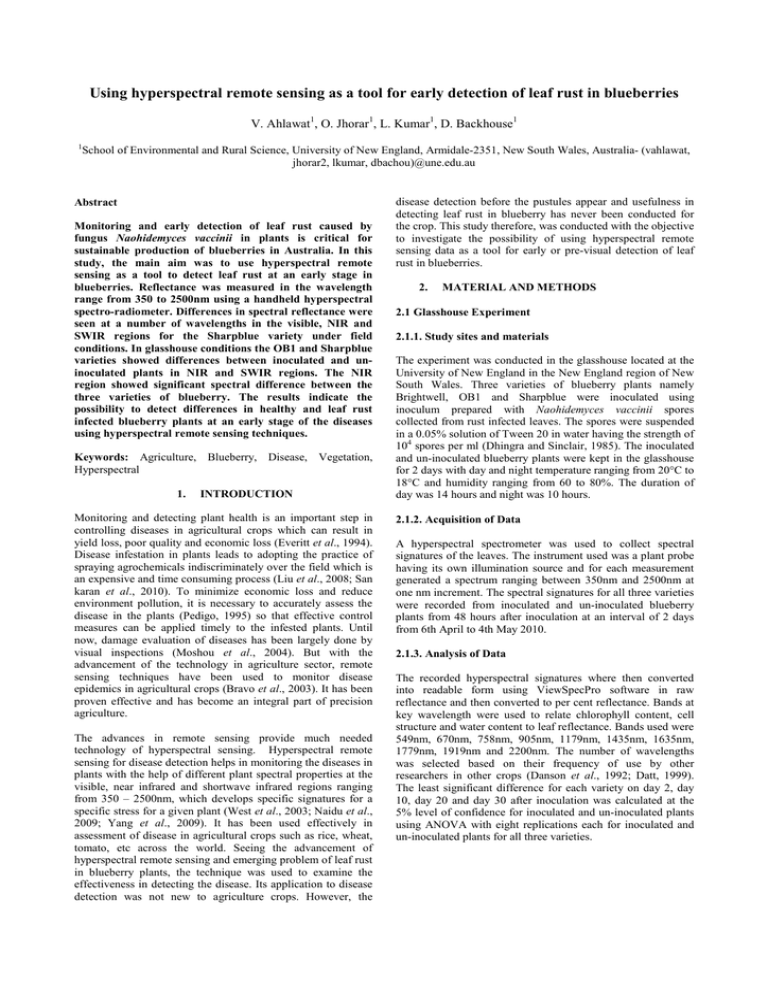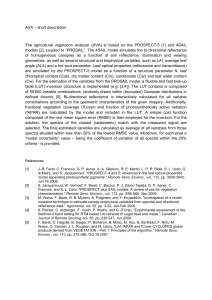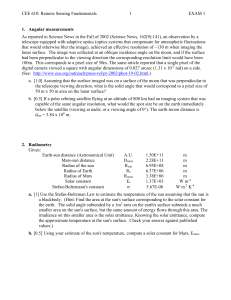Using hyperspectral remote sensing as a tool for early detection... V. Ahlawat , O. Jhorar
advertisement

Using hyperspectral remote sensing as a tool for early detection of leaf rust in blueberries V. Ahlawat1, O. Jhorar1, L. Kumar1, D. Backhouse1 1 School of Environmental and Rural Science, University of New England, Armidale-2351, New South Wales, Australia- (vahlawat, jhorar2, lkumar, dbachou)@une.edu.au Abstract Monitoring and early detection of leaf rust caused by fungus Naohidemyces vaccinii in plants is critical for sustainable production of blueberries in Australia. In this study, the main aim was to use hyperspectral remote sensing as a tool to detect leaf rust at an early stage in blueberries. Reflectance was measured in the wavelength range from 350 to 2500nm using a handheld hyperspectral spectro-radiometer. Differences in spectral reflectance were seen at a number of wavelengths in the visible, NIR and SWIR regions for the Sharpblue variety under field conditions. In glasshouse conditions the OB1 and Sharpblue varieties showed differences between inoculated and uninoculated plants in NIR and SWIR regions. The NIR region showed significant spectral difference between the three varieties of blueberry. The results indicate the possibility to detect differences in healthy and leaf rust infected blueberry plants at an early stage of the diseases using hyperspectral remote sensing techniques. Keywords: Agriculture, Blueberry, Disease, Vegetation, Hyperspectral 1. INTRODUCTION Monitoring and detecting plant health is an important step in controlling diseases in agricultural crops which can result in yield loss, poor quality and economic loss (Everitt et al., 1994). Disease infestation in plants leads to adopting the practice of spraying agrochemicals indiscriminately over the field which is an expensive and time consuming process (Liu et al., 2008; San karan et al., 2010). To minimize economic loss and reduce environment pollution, it is necessary to accurately assess the disease in the plants (Pedigo, 1995) so that effective control measures can be applied timely to the infested plants. Until now, damage evaluation of diseases has been largely done by visual inspections (Moshou et al., 2004). But with the advancement of the technology in agriculture sector, remote sensing techniques have been used to monitor disease epidemics in agricultural crops (Bravo et al., 2003). It has been proven effective and has become an integral part of precision agriculture. The advances in remote sensing provide much needed technology of hyperspectral sensing. Hyperspectral remote sensing for disease detection helps in monitoring the diseases in plants with the help of different plant spectral properties at the visible, near infrared and shortwave infrared regions ranging from 350 – 2500nm, which develops specific signatures for a specific stress for a given plant (West et al., 2003; Naidu et al., 2009; Yang et al., 2009). It has been used effectively in assessment of disease in agricultural crops such as rice, wheat, tomato, etc across the world. Seeing the advancement of hyperspectral remote sensing and emerging problem of leaf rust in blueberry plants, the technique was used to examine the effectiveness in detecting the disease. Its application to disease detection was not new to agriculture crops. However, the disease detection before the pustules appear and usefulness in detecting leaf rust in blueberry has never been conducted for the crop. This study therefore, was conducted with the objective to investigate the possibility of using hyperspectral remote sensing data as a tool for early or pre-visual detection of leaf rust in blueberries. 2. MATERIAL AND METHODS 2.1 Glasshouse Experiment 2.1.1. Study sites and materials The experiment was conducted in the glasshouse located at the University of New England in the New England region of New South Wales. Three varieties of blueberry plants namely Brightwell, OB1 and Sharpblue were inoculated using inoculum prepared with Naohidemyces vaccinii spores collected from rust infected leaves. The spores were suspended in a 0.05% solution of Tween 20 in water having the strength of 104 spores per ml (Dhingra and Sinclair, 1985). The inoculated and un-inoculated blueberry plants were kept in the glasshouse for 2 days with day and night temperature ranging from 20°C to 18°C and humidity ranging from 60 to 80%. The duration of day was 14 hours and night was 10 hours. 2.1.2. Acquisition of Data A hyperspectral spectrometer was used to collect spectral signatures of the leaves. The instrument used was a plant probe having its own illumination source and for each measurement generated a spectrum ranging between 350nm and 2500nm at one nm increment. The spectral signatures for all three varieties were recorded from inoculated and un-inoculated blueberry plants from 48 hours after inoculation at an interval of 2 days from 6th April to 4th May 2010. 2.1.3. Analysis of Data The recorded hyperspectral signatures where then converted into readable form using ViewSpecPro software in raw reflectance and then converted to per cent reflectance. Bands at key wavelength were used to relate chlorophyll content, cell structure and water content to leaf reflectance. Bands used were 549nm, 670nm, 758nm, 905nm, 1179nm, 1435nm, 1635nm, 1779nm, 1919nm and 2200nm. The number of wavelengths was selected based on their frequency of use by other researchers in other crops (Danson et al., 1992; Datt, 1999). The least significant difference for each variety on day 2, day 10, day 20 and day 30 after inoculation was calculated at the 5% level of confidence for inoculated and un-inoculated plants using ANOVA with eight replications each for inoculated and un-inoculated plants for all three varieties. 2.2. Field Experiment 2.2.1. Acquisition of Data The leaves were collected from Sharpblue variety grown at Coffs Harbour, NSW and then arranged according to the disease severity into six different categories. The category healthy represented no disease where as category very high represented maximum disease severity. The spectral signatures were recorded from fresh leaves collected in these categories using the same hyperspectral spectro radiometer that was used for the glasshouse experiment. 2.2.2. Analysis of Data The reflectance obtained from the leaves was converted to raw reflectance and key bands used for analysis were the same bands indentified during the glasshouse experiment. The bands identified were 549nm, 670nm, 758nm, 905nm, 1179nm, 1435nm, 1635nm, 1779nm, 1919nm and 2200nm.The least significant difference was calculated for various wavelengths at the 5% of level of confidence for inoculated and un-inoculated replications by using the single factor ANOVA for each of the category to determine whether there were any statistical significant differences between the spectral wavelengths for the healthy and diseased leaves. 3. RESULTS AND DISCUSSION 3.1. Glasshouse Experiment 3.1.1. Sharpblue Blueberry Variety The inoculated leaves after 10 days showed significant increase in spectral reflectance over the un-inoculated plants of Sharpblue in near infra red region (NIR) at 1179nm wavelength (Fig 1). However, it was not in accordance with the findings of Gausmann et al., (1969) according to which the diseased leaves showed an increase in the reflectance. However, this may not always be true combined effect of the water content of leaves and leaf structure sometimes can modify the reflectance thus making it very difficult to separate the effect (Datt, (1999). Fig 1: Difference between the inoculated and un-inoculated plant of Sharpblue variety at visible region and shortwave infrared region 20 days after inoculation 3.1.2. OB1 Blueberry Variety At 758nm and 905nm wavelengths significant decrease in reflectance was observed from inoculated leaves 20 days after inoculation (Fig 2) probably due to stress, resulting in less internal scattering at the cell structure (Gausmann et al., 1969) indicating loss of leaf area, foliage density or some other changes in vegetation characteristics (Kollenkark et al., 1982; Gausman, 1974). In this variety, no trend in the per cent reflectance values in SWIR region representing water related stress in plants was observed (Pierce et al., 1990; Buschmann and Nagel, 1993). But this does not necessarily indicate that there was no water loss in diseased plants as compared to healthy plants (Apan et al., 2005) as the trend have already been observed clearly in terms of cell structure damage in inoculated plants at 758nm and 905nm wavelength near infrared region. After 20 days of inoculation Sharpblue variety showed significant difference between the inoculated and un-inoculated plants at 549nm wavelength (Fig 1). It may be due to the fact that this wavelength has been of greater importance in indicating the chlorophyll related stress in plants (Penuelas et al., 1994; Young and Britton, 1990). The significance at the 549nm wavelength indicates an increase in the reflectance for the inoculated plants and decrease in the reflectance for the uninoculated plants thus reflecting plants stress related to chlorophyll (Carter, 1993). Furthermore, the per cent reflectance values of inoculated and un-inoculated Sharpblue variety showed a significant difference in shortwave infrared region at the 1435nm, 1779nm, and 1919nm wavelengths after 20 days of inoculation. This difference probably distinguishes the inoculated and uninoculated plants due to water related stress (Pierce et al., 1990; Buschmann and Nagel, 1993) thereby showing the trend of increasing reflectance for inoculated plants and decreasing reflectance for un-inoculated plants at 1435nm, 1779nm and 1919nm bands. Fig 2: Difference between the inoculated and un-inoculated plant of OB1 variety at near infrared region. 3.1.3. Brightwell Variety Reflectance was not significantly different at the 5% of level of confidence for any of the wavelengths between inoculated and un-inoculated replications of Brightwell variety. This was probably because this variety is resistant to leaf rust. Apparently the disease severity was very low or negligible in the inoculated plants of this variety. 3.2. Reflectance for varietal difference The spectra have showed differences between varieties in the NIR region and thus can be used to distinguish between Brightwell, OB1 and Sharpblue on the basis of cell structure (Fig 3). The wavelengths 758nm and 905nm in NIR region are thus able to detect the varietal difference. This may be due to the reason that many species may have similar curves in NIR region does not hold true in this case as these varieties belong to different species. Fig 4: Effect of plant disease severity on radiation of reflectance (per cent) at various wavelengths recorded in sharpblue variety under field conditions. In near infrared region wavelengths 758nm, 905nm and 1179nm strongly indicated the change in cell structure due to the plant stress and state of canopy (Fig 4). In shortwave infrared region wavelengths 1435nm, 1635nm, 1779nm, 1919nm and 2200nm depict the low water content as the reflectance was increasing with the increase in disease severity at most of the wavelengths (Fig 4). CONCLUSION Fig 3: Difference between the Brightwell, OB1 and Sharpblue variety at visible region and near infrared region representing chlorophyll and cell structure. 3.3. Field Experiment Results obtained from field experiments have shown uniform trend at most of the wavelengths in various regions of spectral reflectance curve. In visible range of chlorophyll absorption curve changes at 549nm and 670nm wavelengths for very low, low, highly and very highly disease severity in leaves have shown significant difference (Fig 4). This was perhaps due to the breakdown of chlorophyll pigments and changes in the concentration of the carotenoids (Penuelas et al., 1994; Young and Britton, 1990). The study investigated the possibility of using hyperspectral remote sensing data as a tool for early detection of leaf rust or pre-visual detection of disease in blueberries conducted under glasshouse and field experiments. The research has identified the feasibility to detect leaf rust of blueberry using hyperspectral remote sensing data without the use of vegetation indices. It showed the difference in the reflectance at NIR region: the reflectance was decreasing with decreased internal scattering at the cell due to stress in the mesophyll layer. Results obtained under the glasshouse experiment suggest that the variations in leaf structure can be determined at 758nm and 905nm bands in inoculated and un-inoculated plants of OB1. On the other hand, for Sharpblue variety the leaf reflectance for water absorption at SWIR region was increasing due to a decrease in water content thus indicating the water stress in inoculated plants. The wavelengths useful in detecting the water stress in inoculated plants as compared to un-inoculated plants were 1435nm, 1779nm, 1919nm and 2200nm. In the field experiment, the reflectance difference was seen at visible, NIR and SWIR regions. NIR and SWIR regions indicated a strong trend of reflectance for the healthy and diseased leaves at 758nm, 905nm, 1435nm, 1635nm, 1919nm and 2200nm wavelengths. After analyzing the results for the glasshouse and field experiment it can therefore be concluded that wavelengths 549nm, 670nm, 758nm, 905nm, 1435nm, 1635nm, 1919nm and 2200nm can be used as potential spectral bands in the early detection of leaf rust of blueberry and other agricultural crops. Kollenkark, J.C., Daughtry, C.S.T., Bauer, M.E., and Housley, T.L., 1982. Effects of cultural practices on agronomic and reflectance characteristics of soybean canopies. Agronomy Journal, 74, 751-758. REFERENCES Apan, A., Datt, B., and Kelly. R., 2005. Detection of pests and diseases in vegetable crops using hyperspectral sensing: a comparison of reflectance data for different sets of symptoms. Proceedings of SSC 2005 Spatial Intelligence, Innovation and Praxis: The national biennial Conference of the Spatial Sciences Institute, September 2005. MelbourneBuschmann, C., and Nagel, E., 1993. In vivo spectroscopy and internal optics of leaves as basis for remote sensing of vegetation. International Journal of Remote Sensing, 14, 711-722. Bravo, C., Moshou, D., West, J., McCartney, A., and Ramon, H., 2003. Early disease detection in wheat fields using spectral reflectance. Biosystems Engineering, 84 (2), 137-145. Carter, G.A., 1993. Response of leaf spectral reflectance to plant stress. American Journal of Botany, 80 (3), 2310-243. Dhingra, O., and Sinclair, J., 1985. Basic Plant Pathology Methods. Book Chapter 5: Establishment of Disease and Testing for Resistance, CRC Press, Florida, 142-143. Danson, F.M., Steven, M.D., Malthus, T.J., and Clark, J.A., 1992. High spectral resolution data for determining leaf water content. International Journal of Remote Sensing, 13, 461-470. Datt, B., 1999. Remote sensing of water content in Eucalyptus leaves. Australian Journal of Botany, 47, 909-923. Everitt, J.H., Escobar, D.E., Summary, K.R., and Davis, M.R., 1994.Using airborne video, global positioning system and geographical information system technologies for detecting and mapping citrus blackfly infestations. Southwestern Entomologist 19 (2), 129-138. Gausmann, H.W., Allen, W.A. and Cardenas, R., 1969. Reflectance of Cotton leaves and their structure. Remote Sensing of Environment, 1, 110-122. Gausman, H.W., 1974. Leaf reflectance of near infra red. Photogrammetric Engineering and Remote Sensing, 40, 57-62. Liu, Z.Y., Huang, J.F., Shi, J.J., Tao, R.X., and Zhang, H.Z., 2008. Estimating rice brown spot disease severity based on principal component analysis and radial basis function neural network. Spectroscopy and Spectral Analysis 28 (9), 2156– 2160. Moshou, D., Bravo, C., West, J., Wahlen, S., McCartney, A., and Ramon, H., 2004. Automatic detection of ‘yellow rust’ in wheat using reflectance measurements and neural networks. Computers and Electronics in Agriculture 44 (3), 173–188. Pedigo, L.P., 1995. Closing the gap between IPM theory and practice. Journal of Agricultural Entomology 12, 171–181. Penuelas, J., Gamon, J.A., Fredeen, A.L., Merino, J., and Field, C.B., 1994. Reflectance indices associated with physiological changes in nitrogen and water limited sunflower leaves. Remote Sensing on Environment, 14, 169-182. Pierce, L.L., Running, S.W., and Riggs, G.A., 1990. Remote detection of canopy water stress in coniferous forestd using NS001 thematic mapper simulator and the thermal infra red multispectral scanner. Photogrammetric Engineering & Remote Sensing, 56 (5): 5710-586. Sankarana, S., Mishraa, A., Ehsania, R., and Davis, C., 2010. A review of advanced techniques for detecting plant diseases. Computers and Electronics in Agriculture 72 (2010) 1–13. West, J.S., Bravo, C., Oberit, R., Lemaire, D., Moshou, D., and McCartney, H.A., 2003. The potential of optical canopy measurement for targeted control of field crop diseases. Annual Review of Phytopathology 41, 593–614. Yang, Z., Rao, M.N., Elliott, N.C., Kindler, S.D., and Popham, T.W., 2009. Differentiating stress induced by greenbugs and Russian wheat aphids in wheat using remote sensing. Computers and Electronics in Agriculture 67 (1–2), 64–70. Young, A., and Britton, G., 1990. Carotenoids and stress. In R.G. Alscher & J.R. Cumming (Eds), Stress response in plants: Adaptation, acclimation mechanisms, 87-112. New York.






